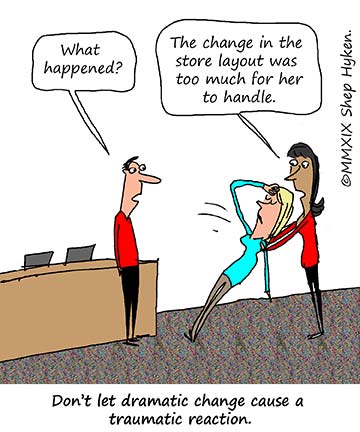
A Dramatic Change Doesn't Have to Be a Traumatic Change
The word dramatic is a great word. When you use it to describe changes you make to improve customer service, it has a positive meaning.
It sounds like you're making big changes for the better. However, if you shorten the word to drama, it takes on an entirely different meaning—one that's negative. Merriam-Webster's definition for how the word is used in this context is that it is "a state, situation, or series of events involving interesting or intense conflict of forces."
So, make dramatic changes, but don't let them cause any drama. That drama could turn your dramatically positive experience into a traumatically bad experience.

Photo courtesy of Shep Hyken.
What got me thinking about this was a recent conversation with Antony Brydon, the CEO and co-founder of Directly, a support automation company. We were talking about how sometimes a company will make a change that dramatically—in a negative way—impacts the customer. Specifically, he mentioned that as Artificial Intelligence (AI) started to take hold, as cool as it was for the company, it wasn't yet a great experience for the customer. Customers paid the price for companies trying out their new technology. Brydon mentioned the drama that it caused, which prompted my response and the title of this article: a dramatic change doesn't have to be a traumatic change.
So back to the idea that drama could turn the positive experience into a traumatically bad experience. That word traumatic can be a little concerning. Going back to the dictionary, Merriam-Webster's definition of the word traumatic is "psychologically or emotionally stressful in a way that can lead to serious mental and emotional problems." Ouch! A broader definition and, one that is much softer, is that it is something that causes distress or anxiety. Regardless of the definition, trauma is not something you want your customers to experience.
This is all about being customer focused. Whenever you make any kind of change to your product, process, price—anything—you must ask yourself, "How is this going to impact the customer?" The answer may be positive or negative, but when you ask that question and get an honest response, you are at least aware of the benefits and pitfalls of the change. If a negative outcome is likely, one so severe that it could cause drama or even trauma, you may want to consider alternatives.
Change can be good. It is often needed to update systems and processes that are outdated or inefficient. This can lead to a better customer—and employee—experience overall. One thing is certain: Change is inevitable. Just remember, if you need to make a change that is dramatic, take steps to ensure that it won't end up being traumatic for your customers.
Shep Hyken is a customer service expert, keynote speaker, and New York Times bestselling business author. For information, contact 314-692-2200 or www.hyken.com. For information on The Customer Focus™ customer service training programs, go to www.thecustomerfocus.com. Follow on Twitter: @Hyken.
(Copyright © MMXIX, Shep Hyken)
This article was republished with permission and originally appeared at Shep Hyken.



